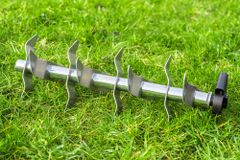
As winter weather approaches, you should start thinking ahead about lawn aeration. If you live in an area with inclement weather and heavy snowfall, your lawn may develop thatch problems. Below is a brief guide on thatch issues, how they affect the landscape, and how aeration improves your lawn care, so it grows long and healthy through spring.
Why Aeration Is Vital for Lawn Care
Lawn Thatch & Aeration
 Lawn thatch develops when a combination of live and dead grass builds up faster than it breaks down, usually under heavy snow. Some thatch provides moisture and insulation against extreme temperature changes. However, too much thatch causes the roots to become blocked, which reduces their access to essential nutrients and elements. This causes root damage and rot if the thatch becomes wet during snowy or rainy periods. Aeration is highly recommended to eliminate thatching issues and help the lawn breathe.
Lawn thatch develops when a combination of live and dead grass builds up faster than it breaks down, usually under heavy snow. Some thatch provides moisture and insulation against extreme temperature changes. However, too much thatch causes the roots to become blocked, which reduces their access to essential nutrients and elements. This causes root damage and rot if the thatch becomes wet during snowy or rainy periods. Aeration is highly recommended to eliminate thatching issues and help the lawn breathe.
How Aeration Works
Lawn aeration should be performed in the fall or spring after debris has accumulated. Professional lawn care companies remove the debris and break up compacted soil by poking small holes into the landscape to allow air to flow through. The small holes also let water and nutrients penetrate deep into the roots. This creates stronger and more luscious lawn. After aeration, make sure that you keep up with regular lawn care such as mowing, fertilizing, and watering.
If you’re looking into aeration to take your lawn care to the next level, contact Landscape Carolina in Lancaster, SC. These landscape professionals specialize in personalized lawn care and design to enhance your curb appeal, increase the home’s resale value, and improve the overall look of the property. See a full list of their landscaping services online or call (803) 289-7888 for more information.
About the Business
Have a question? Ask the experts!
Send your question

